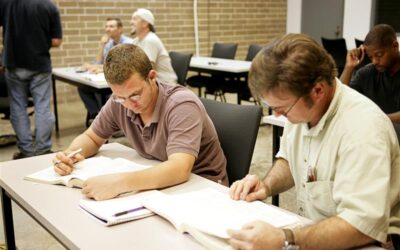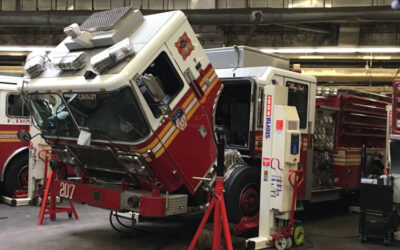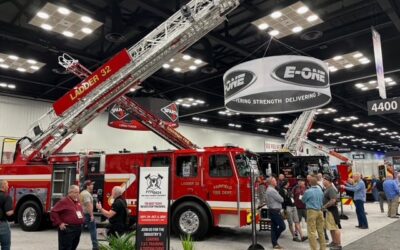By Jason S. Darley
The Darley PSM 1500 Pump has continued to surge in popularity with many fire departments. Both the Detroit (MI) Fire Department and Boston (MA) Fire Department have been featured in recent Darley “We Switched” advertising campaigns as new Darley customers joining the ranks as one of the many departments that have been making “The Switch” to Darley pumps. Both Detroit and Boston have selected the Darley PSM and have had great success with it.
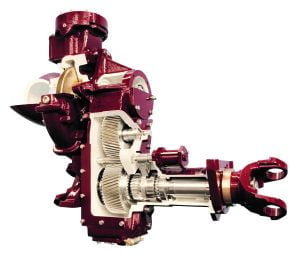
The Darley PSM 1500 Pump has continued to surge in popularity with many fire departments. (All photos courtesy of Darley.)
The PSM pump has been a reliable workhorse for decades for many of Darley’s long-term pump customers, or “Darley Demanders,” of which Boston and Detroit are now proudly classified. The PSM is a product that has lent itself to both high performance, improved packaging with a reduced GVWR (gross vehicle weight rating) impact, and significantly lowered the total cost of ownership in these customers’ apparatus.
High Performance
Darley holds itself to a high standard in performance. A historical practice in many department specification processes has been to “de-rate” a pump; in other words, to buy a pump rated much higher than the desired flows and rate it lower to eliminate the possibility of the pump not passing an annual service test after years of service and resultant wear. At Darley, we hold ourselves to a minimum of 10% reserve capacity on our NFPA ratings that we publish or advertise, with many of our pumps exhibiting significantly higher reserve capacities. Our customers commonly report the PSM flowing in excess of 1,800 gallons per minute (gpm) from draft. This practice eliminates the need for “de-rating” and provides our customers the peace of mind that years down the road at an annual service test the pump will “Pump like a Champion.” Incidentally our pumps had been marketed as Champion Fire Pumps from the early 1900s through the 1990s, and while we may have changed our branding, the concept remains.
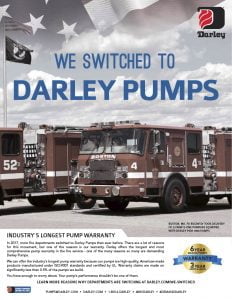
The Boston (MA) Fire Department recently took delivery of 23 new E-ONE pumpers equipped with Darley PSM 1,500-gallons-per-minute pumps.
Improved Packaging and Serviceability & Reduced GVWR Impact
A full-bodied midship pump can add significant weight and drive the GVWR of the apparatus. In today’s fire service, and the trend we’ve seen for a couple of decades, there has been an increase in non-fire-related calls to the fire departments we serve. This change in call volume metrics has driven a need for more solution-providing equipment as we’ve seen an emergence of new emergencies, and technologies have developed and driven the call volume metrics. This new equipment needs a space to be stored and adds weight to the vehicle. That said, even a lower volume of actual fire calls doesn’t change the flow rates we need to be prepared with in pump selection.
We, as pump manufacturers and apparatus OEM’s, have also seen a significant encroachment on the pump house resulting from 2013 EPA (Environmental Protection Agency) changes and emissions requirements with exhaust treatment systems being slammed right into “our space” for mounting a split shaft pump.
The PSM follows Darley’s unique modular design nature, where, like LEGO™, we take many different components to create the product configuration necessary for packaging and easing both the assembly process and, long term, the serviceability.
The PSM typically ships to an OEM at a weight of less than 500 pounds, depending on the options and configuration provided. Compare that to up to four times that weight of available pumps in the same 1,500-gpm NFPA rating class…a significant pick up to carry more equipment and/or more water, while having the flow needed.
Total Cost of Ownership
In sales calls and presentations on the PSM and other Darley products, I am often asked: “Okay, what should we have on the shelves when we switch to your pumps?” or “What can we expect to fail or need to replace after a few years?” My answer has never changed: “If there were something that we expected you to need to replace or that would fail after a few years, we would change it immediately.” Quality and dependability provided through constant improvement are what we provide for our customers and we believe is what our customers should expect from us as a partner and supplier.
The paragraph above admittedly and usually makes me sound a bit like a “salesperson,” so to back that up there is a long line of “Darley Demanders” who are a phone call away on our reference list.
The next question (after I’ve given out the reference list, of course) is generally “What should we expect in terms of maintenance?” The answer is “On the PSM we provide a maintenance-free mechanical seal as standard; from there, change the oil as needed, check and change anodes as needed, and have a nice day.” The Darley PSM is truly about as low maintenance as a pump can get.
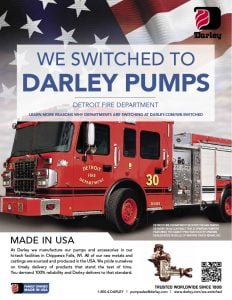
The Detroit (MI) Fire Department switched to Darley 1,500-gpm PSM pumps on its engines.
Eighty percent of pumpers in the fire service today are equipped with a 1,500-gpm single-stage pump, according to industry statistics. If your department is spec’ing a new pumper that falls in this category, the Darley PSM is an excellent choice. If you determine a higher flow rating is needed, we also offer a very similar product in our TSM which utilizes many of the same components and design features as the PSM and has ratings to 2,000-gpm, but we will save that story for another day.
Jason S. Darley is the North American sales manager for Darley.



